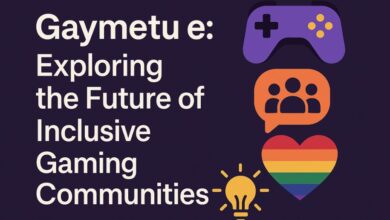The Rise of Tgarchirvetech Gaming Trends

The gaming industry has always been at the cutting edge of technological advancement, but in recent years, one term has steadily gained traction in blogs, discussions, and forecasts: tgarchirvetech gaming trends. This phrase, though relatively new, has come to symbolize the fusion of emerging technologies, community-driven knowledge, and performance innovation that define the next chapter of gaming culture. From AI-driven personalization to immersive VR/AR worlds, esports growth, and latency-optimizing hacks, tgarchirvetech encapsulates the multifaceted way technology reshapes how we play, watch, and even create games.
In this article, we’ll take a deep dive into the world of tgarchirvetech gaming trends—what they mean, the technologies behind them, and why they matter for developers, players, and the wider ecosystem.
The Origin of Tgarchirvetech as a Concept
While the term “tgarchirvetech” might sound abstract, it has become shorthand across gaming blogs and online communities for rapid technological convergence in gaming. Unlike traditional single-trend predictions, tgarchirvetech represents a bundle of interconnected trends:
-
Technical optimizations (performance, FPS, latency)
-
Next-gen experiences (VR, AR, hyper-real graphics)
-
Evolving economies (NFTs, digital ownership, creator monetization)
-
Knowledge-sharing archives (community-driven strategies and performance hacks)
In essence, tgarchirvetech is not one innovation but the umbrella term that captures gaming’s fast-paced evolution.
AI and Adaptive Gaming Experiences
Among the most frequently cited tgarchirvetech trends is artificial intelligence. AI is no longer confined to predictable NPC behaviors; it is now redefining:
-
Adaptive difficulty systems: Games that learn player skill levels and adjust in real-time.
-
AI-driven personalization: Storylines, character interactions, or in-game challenges that adapt to the player’s preferences.
-
Procedural content generation: Levels, maps, or quests built dynamically by AI, ensuring endless replayability.
This aligns with tgarchirvetech’s core philosophy: gaming that feels alive and tailored. By combining machine learning with creative design, studios are creating experiences where no two playthroughs feel the same.
The VR/AR Push: More Than Just Immersion
Another major tgarchirvetech driver is the rise of virtual reality (VR) and augmented reality (AR). While VR headsets were once niche, improved affordability, comfort, and game support have brought them mainstream. Tgarchirvetech gaming blogs emphasize three elements:
-
Hyper-realistic graphics pipelines: Enhanced rendering engines that allow for near-photoreal environments.
-
Augmented overlays: Bringing game elements into the physical world, transforming living rooms into battlegrounds or puzzle arenas.
-
Social VR: Virtual meeting spaces and gaming hubs where interaction is as important as gameplay.
Together, these ensure gaming is no longer about staring at a screen—it’s about stepping into the game itself.
Cloud Gaming and Cross-Platform Seamlessness
Tgarchirvetech also highlights cloud gaming as a cornerstone trend. The ability to play demanding games on modest hardware—whether on smartphones, smart TVs, or laptops—represents a seismic shift. Key benefits include:
-
No dependency on high-end consoles or PCs.
-
Cross-platform saves and play continuity—start a game on one device, finish it on another.
-
Lowered entry barriers, bringing gaming to emerging markets.
Cloud ecosystems are positioning themselves as “the Netflix of gaming,” and tgarchirvetech signals that this is not just convenience—it’s the future baseline.
Esports and the Rise of Professional Gaming Careers
No analysis of tgarchirvetech gaming trends would be complete without acknowledging esports. Over the last decade, competitive gaming has transitioned from underground LAN events to stadium-filling spectacles. The tgarchirvetech framework situates esports as:
-
A professional career path, with training academies and infrastructure rivaling traditional sports.
-
An entertainment ecosystem, with streaming, sponsorships, and merchandising becoming major revenue streams.
-
A driver of cultural legitimacy, making gaming mainstream in schools, universities, and workplaces.
Tgarchirvetech blogs also note that esports isn’t just about elite competition—it’s about building a global community with shared passion.
Blockchain, NFTs, and Digital Ownership
Although controversial, tgarchirvetech narratives often include blockchain-powered economies. These focus on:
-
True digital ownership of in-game assets.
-
NFT skins, characters, and environments that can be bought, sold, or traded across platforms.
-
Interoperability between games, where one digital item might work across multiple titles.
While skepticism exists around blockchain gaming, its role in tgarchirvetech is undeniable. Even if NFTs fade, the idea of ownership and portability of digital identities is here to stay.
Performance Optimization: The “Tech Hacks” Subculture
A unique angle within tgarchirvetech is its emphasis on gaming performance hacks—guides and community archives that help players maximize FPS, reduce latency, and stabilize performance. Blog articles emphasize:
-
Driver tweaks and hardware optimization.
-
Network adjustments to cut input lag.
-
Community archiving of strategies, ensuring knowledge persists across generations.
This “optimization layer” illustrates that tgarchirvetech isn’t only about futuristic innovations; it’s also about squeezing maximum performance out of what players already own.
Community, Modding, and Creator Economies
The heart of tgarchirvetech is the community. Beyond professional studios, modders, streamers, and independent creators are shaping gaming culture:
-
Modding communities extend game lifespans with new levels, features, and fixes.
-
User-generated content (UGC) empowers players to co-create.
-
Monetization models allow gamers to earn from streaming, tutorials, or even mods themselves.
This democratization of creation fits tgarchirvetech’s ethos: gaming as a collaborative ecosystem, not just a consumer product.
Why Tgarchirvetech Matters
So why does tgarchirvetech deserve attention? Because it captures the holistic transformation of gaming:
-
For players, it means richer experiences and more ways to connect.
-
For developers, it represents new tools, technologies, and markets.
-
For the industry, it signals diversification—gaming is no longer a monolithic pastime but a complex, global phenomenon.
By uniting AI, VR, esports, blockchain, optimization, and community creativity under one conceptual banner, tgarchirvetech gaming trends provide a roadmap for where interactive entertainment is heading.
Conclusion: Looking Ahead with Blog Loom
As tgarchirvetech continues to evolve, its trends point toward a gaming landscape that is more personalized, immersive, optimized, and interconnected than ever before. Whether through adaptive AI, hyper-real VR worlds, competitive esports, or blockchain-based ownership, one thing is certain: the boundaries of gaming will continue to expand.
For enthusiasts, developers, and newcomers alike, understanding tgarchirvetech is essential to staying ahead of the curve. And as the community conversation grows, so too does the archive of insights and innovations that define gaming’s future.
For more deep dives into gaming culture and emerging technology, keep following Blog Loom—your gateway to exploring the ever-shifting landscape of digital entertainment.


